Now I’m not trying to teach you to suck eggs here. I know that most of you have been here for a while and that you probably by now have your cleansing routine buttoned down. I’m so proud. Because it’s a routine though, we do it every day. It becomes mundane and we start to cut corners. We are busy people and bad habits can start to creep in. Let’s all take a moment to reassess and make sure we’ve got this down.

Common Mistake No.1 - Your Water Temperature is Wrong
We’re a little complacent when it comes to water temperature. The best tool for effective cleansing is something that costs you nothing: steam. Make sure your water is warm-to-hot (not too hot or you’ll dry out your skin). Use your favourite cleanser to cleanse your skin and then use a flannel to take the cleanser off, allowing a moment for it to rest on your face. The steam from the flannel will help your pores to open for a better cleanse. Although it’s tempting to skip this step, finish with a splash of cold water to calm your skin and close the pores. Plus, it’s a great way to wake you up in the morning!
Common Mistake No.2. – Too Speedy
Never be tempted to skip the second cleanse. Our daily lives can take a real toll on our skin, what with makeup and general dirt and grime. One cleanse just isn’t enough to rid your skin of all that and actually cleanse the skin. Yes, one cleanse is better than none, but if it’s worth doing it’s worth doing right no? Use a cleanser strong enough to cut through make up, such as Decleor Micellar Cleansing Oil, for your first cleanse, then ramp it up with a cleanser more targeted to your needs for your second cleanse.
Common Mistake No.3 – You’re Using Too Many Products
Less is more. You don’t need to exfoliate every day. Sometimes the simple routines are the best routines and it give your skin time to adjust.
Common Mistake No 4. - Misunderstanding Your Skin’s Needs
I see this most commonly in acne sufferers. Most find that the acne is topical and reoccurring in the same areas, such as the chin or forehead. They then of course reach for a medicated cleanser all over. Just stop. You’re just overwhelming the rest of your skin and drying it out. Only use the acne wash where it’s needed, and make sure to keep the rest of the face hydrated with a less intense cleanser. Break your skin down into ‘zones’ and treat each zone according to its concern.
Are you guilty of any of these common mistakes? Not anymore!
xoxo




